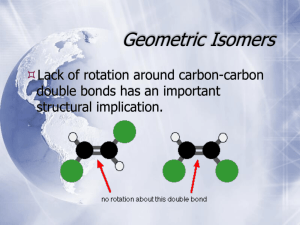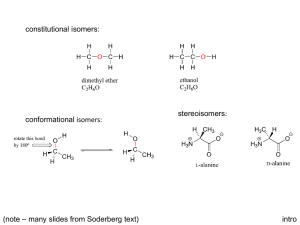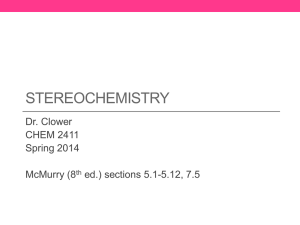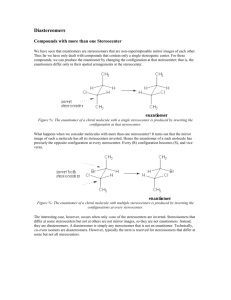Stereochemistry
advertisement
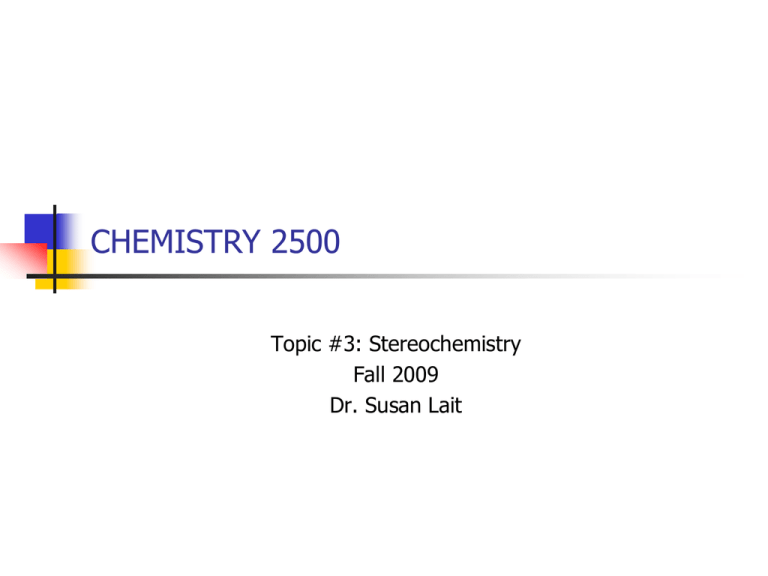
CHEMISTRY 2500 Topic #3: Stereochemistry Fall 2009 Dr. Susan Lait Stereoisomers We have established that molecules which have the same molecular formula but different connectivity are referred to as constitutional isomers. It is also possible to have molecules which have the same molecular formula and the same connectivity but which are still not superimposable. These are stereoisomers (literally, “isomers by shape”). You have seen examples of stereoisomers in both CHEM 1000 and CHEM 2000: cis- and trans-diamminedichloroplatinum(II) (cisplatin is an anti-cancer drug transplatin is toxic) 2 Stereoisomers: Geometric Isomers cis-1,2-dichlorocyclopentane and trans-1,2-dichlorocyclopentane These are examples of geometric isomers, isomers which can be distinguished by whether the two most important* groups are on the same side of a ring/double bond (Z for zusammen = ‘together’, or cis) or on opposite sides of a ring/double bond (E for entgegen = ‘across’, or trans). * The importance of a group in this context is determined by the mass of the first atom. So, Cl is more important than CH3 which is, in turn, more important than H. We will look at rules for distinguishing between groups beginning with the same atom shortly. 3 Stereoisomers: Geometric Isomers Why use E- or Z- when we could just use cis- or trans-? Consider the following molecule: .. . .. . Does it look like it should be cis- or trans-? Use the rules in the box on the previous page to assign which is the more important group attached to each carbon of the double bond then name the molecule including either the E or Z designation at the beginning of the name. As you can see, using the E/Z designation causes less confusion in situations like these. The cis/trans designation is usually reserved for molecules in which each atom has one group and one hydrogen atom so that there is no ambiguity. 4 Stereoisomers: Cahn-Ingold-Prelog Convention The complete set of rules for assigning priority are referred to as the Cahn-Ingold-Prelog convention. For geometric isomers you are considering the groups attached to each atom of the double bond (or ring) separately. Compare the atomic numbers of the atoms immediately attached. The one with a higher atomic number (Z) is of higher priority. Lone pairs are considered to have Z = 0: .. .. .. . .. . .. If the atoms are isotopes of the same element (same Z), the .. heavier isotope is of higher priority: .. .. .. If the atoms attached are the same, look at the next “shell” of atoms one bond farther and compare those. Look for the highest individual atomic number (not the ..highest average atomic number): . .. . .. . .. . .. . .. . If a group contains bonds, treat each as an additional bond to an atom of the same element. (see next page for “phantom atoms”) 5 Stereoisomers: Cahn-Ingold-Prelog Convention When dealing with bonds, work one “shell” at a time until you find a difference: .. 2 3 .. 2 3 2 1 .. 0 2 1 2 Shell #1: C0 bonded to C1 vs. C1 (no difference) Shell #2: C1 bonded to N2/N2/C0/H2 vs. N2/N2/C0/H2 (no difference) Shell #3: N2 bonded to C1/H3/H3 vs. C1/C1/H3 (difference!) 3 2 2 3 1 2 3 0 1 2 Shell #1: C0 bonded to C1 vs. C1 (no difference) Shell #2: C1 bonded to C0/C2/H2/H2 vs. C0/C2/C2/H2 (difference!) 3 2 6 Stereoisomers: Cahn-Ingold-Prelog Convention Determine which group gets higher priority for each of the following double bond “halves”: .. . . .. .. .. . .. . .. .. .. .. . .. . .. . . .. . . Assign the following compounds as having E- or Z- configuration: .. .. .. .. .. .. .. .. . .. . .. . . .. .. .. 7 Stereoisomers: Enantiomers and Chirality Geometric isomers can often be distinguished by looking at their structures on paper; however, this is not true for all kinds of stereoisomers. The easiest way to tell whether two molecules with the same connectivity are stereoisomers or just the same molecule (possibly rotated or twisted) is to build a model of each then determine whether or not the two models can be superimposed. When doing so, you are allowed to rotate bonds or flip rings but you are not allowed to break or form bonds. Consider, for example, the two geometric isomers of 1,2dichlorocyclopentane: Build two different trans-1,2-dichlorocyclopentane molecules which are mirror images. They are not superimposable (no matter how much you rotate them). 8 Stereoisomers: Enantiomers and Chirality The two different trans-1,2-dichlorocyclopentane molecules are referred to as enantiomers (mirror images that are not superimposable): Any molecule which has an enantiomer is referred to as chiral or asymmetric. Chiral molecules have one or more stereocenters (points in a molecule about which exchanging two groups gives a stereoisomer; often tetrahedral atoms with four different groups attached). Find the stereocenter(s) in trans-1,2-dichlorocyclopentane and mark it/them on your drawing above. 9 Stereoisomers: Enantiomers and Chirality Build two mirror images of cis-1,2-dichlorocyclopentane: These two mirror images *can* be superimposed. As such, cis-1,2-dichlorocyclopentane can be described as achiral (literally “not chiral”) even though it has stereocenters. Find the stereocenter(s) in cis-1,2-dichlorocyclopentane and mark it/them on your drawing above. Achiral compounds that have stereocenter(s) are referred to as meso compounds. They can be recognized by the plane of symmetry through the molecule. Find the plane of symmetry in cis-1,2-dichlorocyclopentane. 10 Stereoisomers: Enantiomers and Chirality What if you wanted to indicate one particular enantiomer of trans-1,2-dichlorocyclopentane without having to draw it out? There is a naming convention similar to the E/Z naming convention that allows us to distinguish between enantiomers. According to this convention, each stereocenter is assigned as either R or S. For two molecules to be enantiomers, every stereocenter must have the opposite designation: R-2-chlorobutane is the enantiomer of S-2-chlorobutane (1R,2S,5R)-menthol is the enantiomer of (1S,2R,5S)-menthol but would *not* be the enantiomer of (1R,2R,5R)-menthol. (1R,2S,5R)-menthol and (1R,2R,5R)-menthol would be classified as diastereomers (stereoisomers that are not enantiomers). In order to assign R or S to a stereocenter, it is *essential* that you draw the molecule’s geometry properly using wedge-anddash notation. It will also be helpful to remember that switching any two groups around the stereocenter switches the configuration (from R to S or from S to R). Switching a second 11 time gets you back to the original configuration. Stereoisomers: Enantiomers and Chirality To assign the configuration of a stereocenter: First, assign priority to each of the four groups attached following the Cahn-Ingold-Prelog convention (same as for E/Z), Second, draw the molecule such that the lowest priority group attached to the stereocenter is pointing away from you (i.e. on the dashed line). Third, draw a circular arrow from the top priority group to the second priority group to the third priority group. If the arrow is going clockwise, the stereocenter is R. If the arrow is going counterclockwise, the stereocenter is S. Assign the configuration of each stereocenter in the molecules below: .. . .. . .. .. .. .... .. .. . .. . 12 Stereoisomers: Enantiomers and Chirality Assign the configuration of each stereocenter in the molecules below: .. .. .. .. .. .. .. .. .. 13 Stereoisomers: Enantiomers and Chirality Note that, when switching groups, there is no need to redraw the whole group… .. .. .. . .. . .. .. .. . .. . Note that the two molecules above *are* stereoisomers but they are *not* enantiomers. They are therefore diastereomers. 14 Stereoisomers: Enantiomers and Chirality More practice assigning R and S… .. .. .. .. .. .. .. .. .. . .. . . ... If you ever have a hard time assigning configuration from structures drawn on paper, 15 build a model. Stereoisomers: Enantiomers and Chirality How can you tell the difference between two samples which are enantiomers? They behave identically in any achiral environment and react identically with achiral reagents/systems. They will rotate plane-polarized light in opposite directions. This led to the term “optically active” which was originally used to describe chiral compounds. They interact differently with chiral environments (e.g. biological systems), sometimes with tragic consequences. This is because one enantiomer may “fit” better into the chiral environment – just as your right hand fits better into a righthanded baseball glove. What if a sample consists of a mixture of enantiomers? If a chiral material is made in the lab from achiral starting materials, a 50-50 mixture of each enantiomer results. This is referred to as a racemic mixture. Racemic mixtures do not rotate plane-polarized light (half of the molecules rotate it clockwise but the other half rotate it counterclockwise); however, their properties in biological systems do *not* “average out”. If either enantiomer is toxic, the racemic mixture will also be toxic. 16 Stereoisomers: Enantiomers and Chirality A stereocenter does not have to be a carbon atom. Any atom with tetrahedral or trigonal pyramidal geometry will do: .. .. While a trigonal pyramidal nitrogen atom can serve as a stereocenter at extremely low temperatures, at room temperature, it inverts rapidly (flipping between R and S configuration) so molecules whose only “stereocenter” would be a trigonal pyramidal nitrogen atom are not considered to be chiral. If protonated (making the nitrogen atom tetrahedral), the nitrogen becomes a more stable stereocenter. 17 Stereoisomers: Enantiomers and Chirality Nitrogen inverts configuration (unless tetrahedral cation): Atoms other than carbon? Inversion of Configuration H3CH2C N Ph CH3 H3CH2C N Ph H3CH2C CH3 Ph N CH3 CH3CH2Br H3CH2C Ph N CH3 Br- CH2CH3 18 Stereoisomers: Enantiomers and Chirality There are even chiral molecules whose stereocenter(s) are not the traditional tetrahedral atoms: Br Br C C C Br H Br H C C C H H HO OH OH HO BINOL We will not focus on these molecules in this course. 19 Stereoisomers: Diastereomers We saw earlier than stereoisomers which are not enantiomers are referred to as diastereomers. Diastereomers have different physical and chemical properties and are therefore separable (unlike enantiomers which can only be separated in chiral environments). cis- and trans-1,2-dichlorocyclopentane can also be referred to as diastereomers (which is a more general term than “geometric isomers”). A molecule with only one stereocenter cannot have a diastereomer. Why not? Are the stereoisomers a pair of enantiomers or diastereomers: .. . .. . . ... .. .. .. .. .. 20 Stereoisomers: Diastereomers Draw all possible stereoisomers for the molecule below. Indicate which pairs are enantiomers and which pairs are .. .. .... .. .. diastereomers. .. .. .. .. .. .. .. .. .. Hint: A molecule can have a maximum of 2n stereoisomers (including itself). If there are no meso isomers, there will be exactly 2n stereoisomers. 21 Stereoisomers: Summary Stereochemistree So, you've got two molecules and you want to know their relationship... Is the connectivity the same? No Yes Structural Constitutional isomers Isomers (Positional or Functional) Are they superimposable? Yes No Identical molecules Identical after rotation about single bonds to equivaent conformations? Yes No Conformers They are stereoisomers. Are they mirror images of each other? Yes Enantiomers No Diastereomers 22 Stereoisomers: Fischer Projections Most chemists like to draw chiral molecules in 3D (as we have been doing thus far). Biochemists and a few specialist groups of chemists (e.g. carbohydrate chemists) sometimes use a different drawing convention called the Fischer projection. A Fischer projection is intended to show three-dimensional structure without actually drawing in 3D. The convention is that vertical lines always indicate groups going away from the central atom while horizontal lines always indicate groups coming forward from the central atom: CH2OH CH2OH = CHO CHO Is the R- or the S- isomer depicted above? 23 Stereoisomers: Fischer Projections Fischer projections were developed primarily to represent sugars which contain many chiral centers. The idea is that it is easy to tell whether two molecules are diastereomers or enantiomers by looking at the Fischer projections (which will be mirror images of each other if the molecules are enantiomers). Compare: CH2OH CH2OH vs. CHO CHO CH2OH CH2OH vs. CHO CHO 24
